Microwave Radio System: Calculating RSL & Passive Repeater Purpose
VerifiedAdded on 2023/03/31
|9
|1496
|251
Homework Assignment
AI Summary
This assignment focuses on analyzing a digital microwave radio system operating in the 18GHz band with a 2x2 Mbps transmission capacity, utilizing a passive repeater between two sites. The solution involves calculating the nominal Receive Signal Level (RSL) at the receiver input in dBm under f...
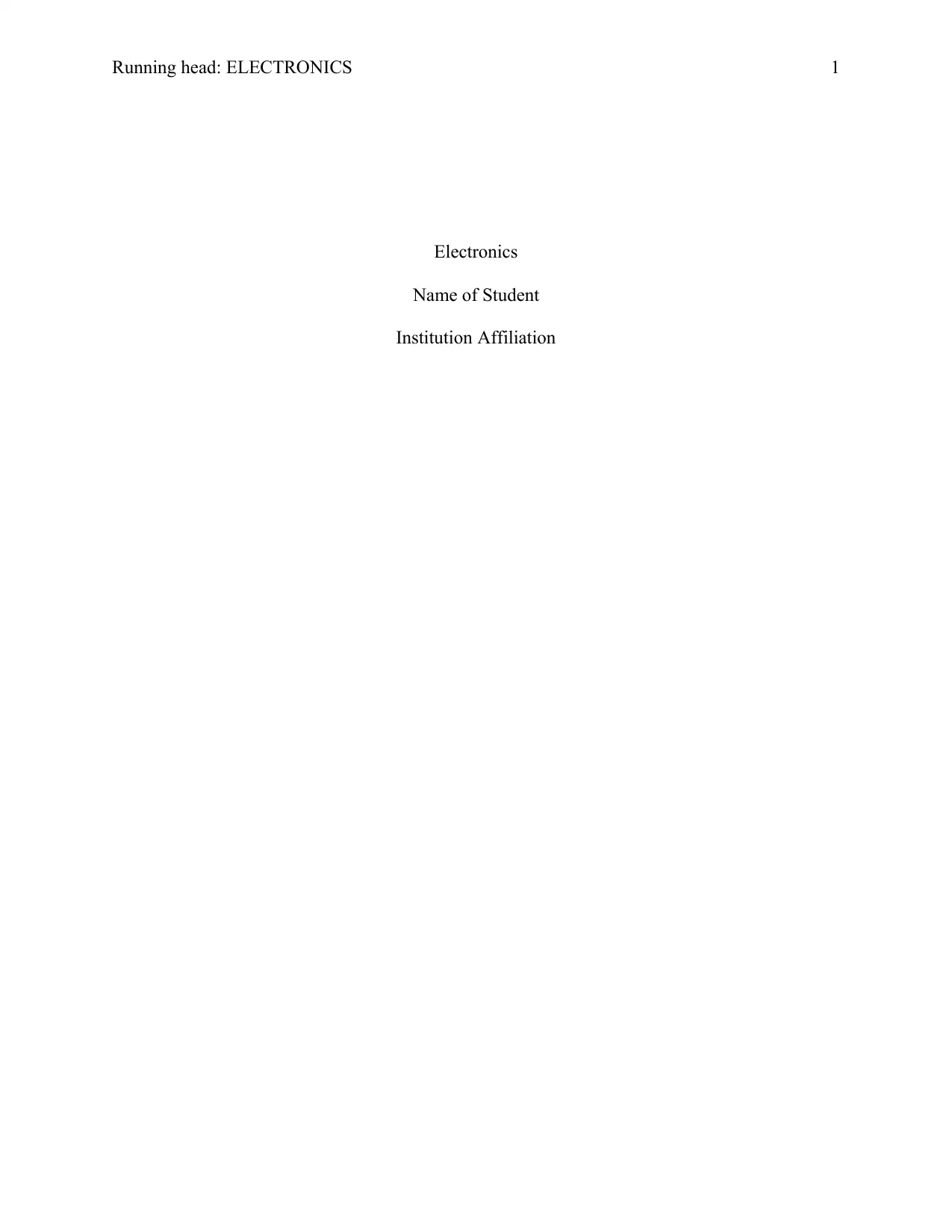
Running head: ELECTRONICS 1
Electronics
Name of Student
Institution Affiliation
Electronics
Name of Student
Institution Affiliation
Paraphrase This Document
Need a fresh take? Get an instant paraphrase of this document with our AI Paraphraser
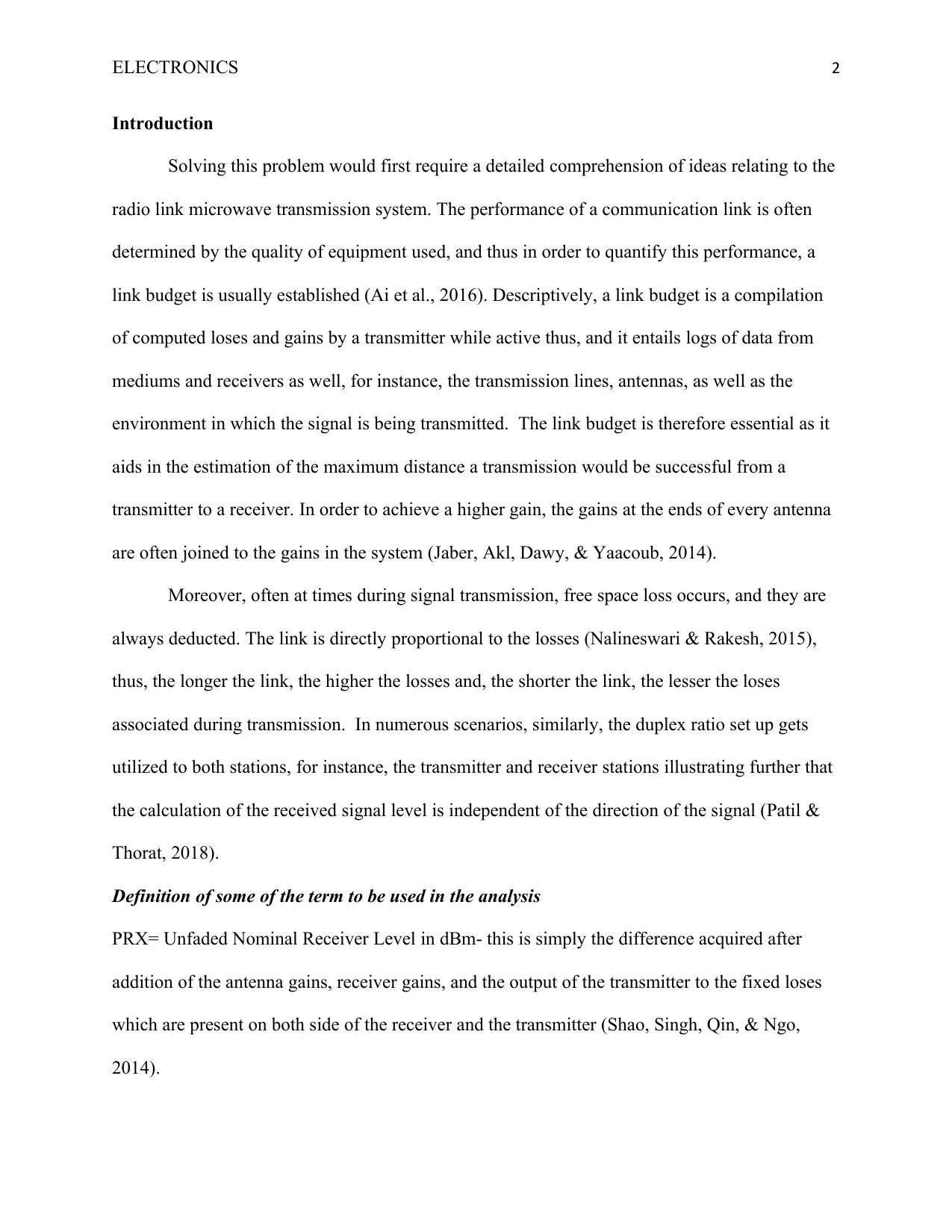
ELECTRONICS 2
Introduction
Solving this problem would first require a detailed comprehension of ideas relating to the
radio link microwave transmission system. The performance of a communication link is often
determined by the quality of equipment used, and thus in order to quantify this performance, a
link budget is usually established (Ai et al., 2016). Descriptively, a link budget is a compilation
of computed loses and gains by a transmitter while active thus, and it entails logs of data from
mediums and receivers as well, for instance, the transmission lines, antennas, as well as the
environment in which the signal is being transmitted. The link budget is therefore essential as it
aids in the estimation of the maximum distance a transmission would be successful from a
transmitter to a receiver. In order to achieve a higher gain, the gains at the ends of every antenna
are often joined to the gains in the system (Jaber, Akl, Dawy, & Yaacoub, 2014).
Moreover, often at times during signal transmission, free space loss occurs, and they are
always deducted. The link is directly proportional to the losses (Nalineswari & Rakesh, 2015),
thus, the longer the link, the higher the losses and, the shorter the link, the lesser the loses
associated during transmission. In numerous scenarios, similarly, the duplex ratio set up gets
utilized to both stations, for instance, the transmitter and receiver stations illustrating further that
the calculation of the received signal level is independent of the direction of the signal (Patil &
Thorat, 2018).
Definition of some of the term to be used in the analysis
PRX= Unfaded Nominal Receiver Level in dBm- this is simply the difference acquired after
addition of the antenna gains, receiver gains, and the output of the transmitter to the fixed loses
which are present on both side of the receiver and the transmitter (Shao, Singh, Qin, & Ngo,
2014).
Introduction
Solving this problem would first require a detailed comprehension of ideas relating to the
radio link microwave transmission system. The performance of a communication link is often
determined by the quality of equipment used, and thus in order to quantify this performance, a
link budget is usually established (Ai et al., 2016). Descriptively, a link budget is a compilation
of computed loses and gains by a transmitter while active thus, and it entails logs of data from
mediums and receivers as well, for instance, the transmission lines, antennas, as well as the
environment in which the signal is being transmitted. The link budget is therefore essential as it
aids in the estimation of the maximum distance a transmission would be successful from a
transmitter to a receiver. In order to achieve a higher gain, the gains at the ends of every antenna
are often joined to the gains in the system (Jaber, Akl, Dawy, & Yaacoub, 2014).
Moreover, often at times during signal transmission, free space loss occurs, and they are
always deducted. The link is directly proportional to the losses (Nalineswari & Rakesh, 2015),
thus, the longer the link, the higher the losses and, the shorter the link, the lesser the loses
associated during transmission. In numerous scenarios, similarly, the duplex ratio set up gets
utilized to both stations, for instance, the transmitter and receiver stations illustrating further that
the calculation of the received signal level is independent of the direction of the signal (Patil &
Thorat, 2018).
Definition of some of the term to be used in the analysis
PRX= Unfaded Nominal Receiver Level in dBm- this is simply the difference acquired after
addition of the antenna gains, receiver gains, and the output of the transmitter to the fixed loses
which are present on both side of the receiver and the transmitter (Shao, Singh, Qin, & Ngo,
2014).
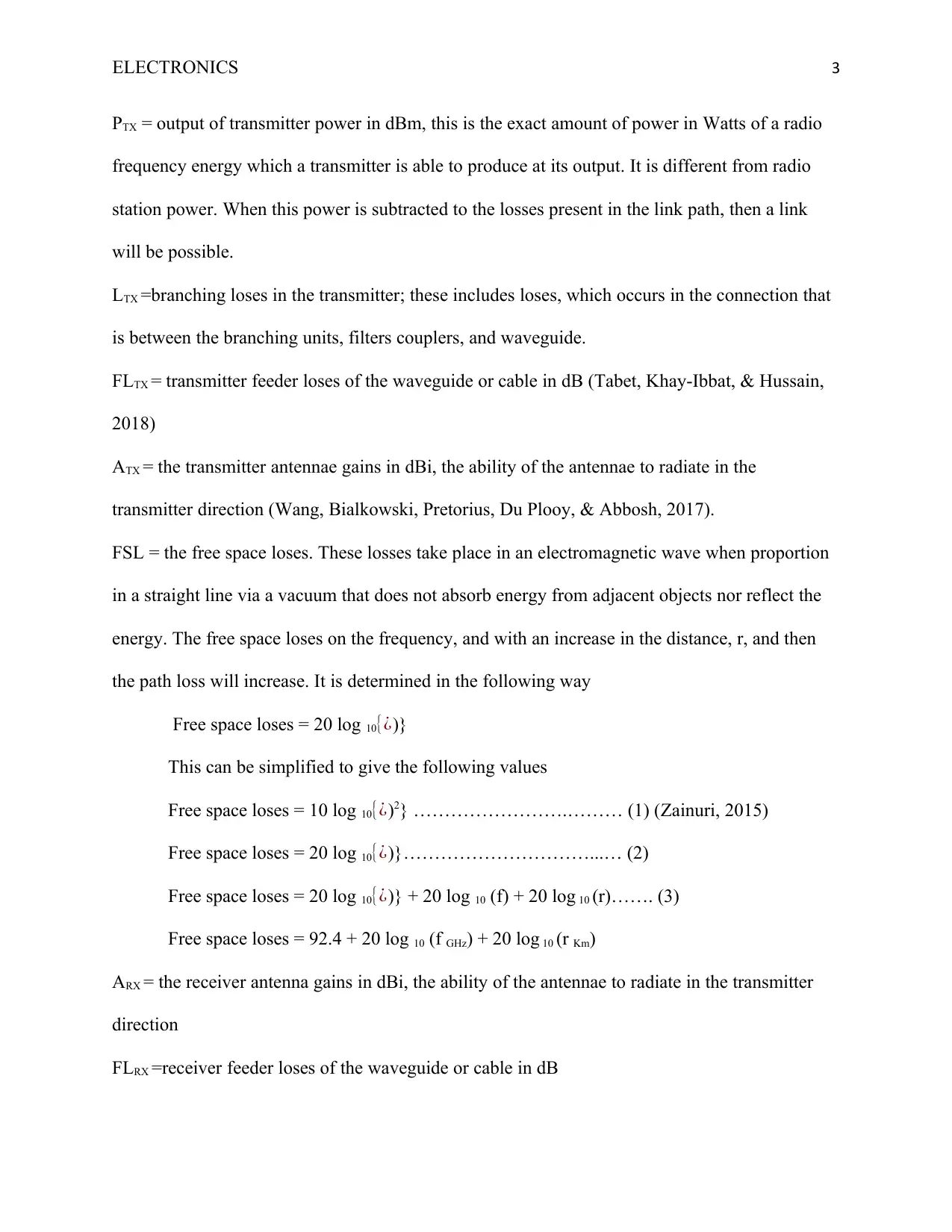
ELECTRONICS 3
PTX = output of transmitter power in dBm, this is the exact amount of power in Watts of a radio
frequency energy which a transmitter is able to produce at its output. It is different from radio
station power. When this power is subtracted to the losses present in the link path, then a link
will be possible.
LTX =branching loses in the transmitter; these includes loses, which occurs in the connection that
is between the branching units, filters couplers, and waveguide.
FLTX = transmitter feeder loses of the waveguide or cable in dB (Tabet, Khay-Ibbat, & Hussain,
2018)
ATX = the transmitter antennae gains in dBi, the ability of the antennae to radiate in the
transmitter direction (Wang, Bialkowski, Pretorius, Du Plooy, & Abbosh, 2017).
FSL = the free space loses. These losses take place in an electromagnetic wave when proportion
in a straight line via a vacuum that does not absorb energy from adjacent objects nor reflect the
energy. The free space loses on the frequency, and with an increase in the distance, r, and then
the path loss will increase. It is determined in the following way
Free space loses = 20 log 10{¿)}
This can be simplified to give the following values
Free space loses = 10 log 10{¿)2} …………………….……… (1) (Zainuri, 2015)
Free space loses = 20 log 10{¿)}…………………………...… (2)
Free space loses = 20 log 10{¿)} + 20 log 10 (f) + 20 log 10 (r)……. (3)
Free space loses = 92.4 + 20 log 10 (f GHz) + 20 log 10 (r Km)
ARX = the receiver antenna gains in dBi, the ability of the antennae to radiate in the transmitter
direction
FLRX =receiver feeder loses of the waveguide or cable in dB
PTX = output of transmitter power in dBm, this is the exact amount of power in Watts of a radio
frequency energy which a transmitter is able to produce at its output. It is different from radio
station power. When this power is subtracted to the losses present in the link path, then a link
will be possible.
LTX =branching loses in the transmitter; these includes loses, which occurs in the connection that
is between the branching units, filters couplers, and waveguide.
FLTX = transmitter feeder loses of the waveguide or cable in dB (Tabet, Khay-Ibbat, & Hussain,
2018)
ATX = the transmitter antennae gains in dBi, the ability of the antennae to radiate in the
transmitter direction (Wang, Bialkowski, Pretorius, Du Plooy, & Abbosh, 2017).
FSL = the free space loses. These losses take place in an electromagnetic wave when proportion
in a straight line via a vacuum that does not absorb energy from adjacent objects nor reflect the
energy. The free space loses on the frequency, and with an increase in the distance, r, and then
the path loss will increase. It is determined in the following way
Free space loses = 20 log 10{¿)}
This can be simplified to give the following values
Free space loses = 10 log 10{¿)2} …………………….……… (1) (Zainuri, 2015)
Free space loses = 20 log 10{¿)}…………………………...… (2)
Free space loses = 20 log 10{¿)} + 20 log 10 (f) + 20 log 10 (r)……. (3)
Free space loses = 92.4 + 20 log 10 (f GHz) + 20 log 10 (r Km)
ARX = the receiver antenna gains in dBi, the ability of the antennae to radiate in the transmitter
direction
FLRX =receiver feeder loses of the waveguide or cable in dB
⊘ This is a preview!⊘
Do you want full access?
Subscribe today to unlock all pages.

Trusted by 1+ million students worldwide
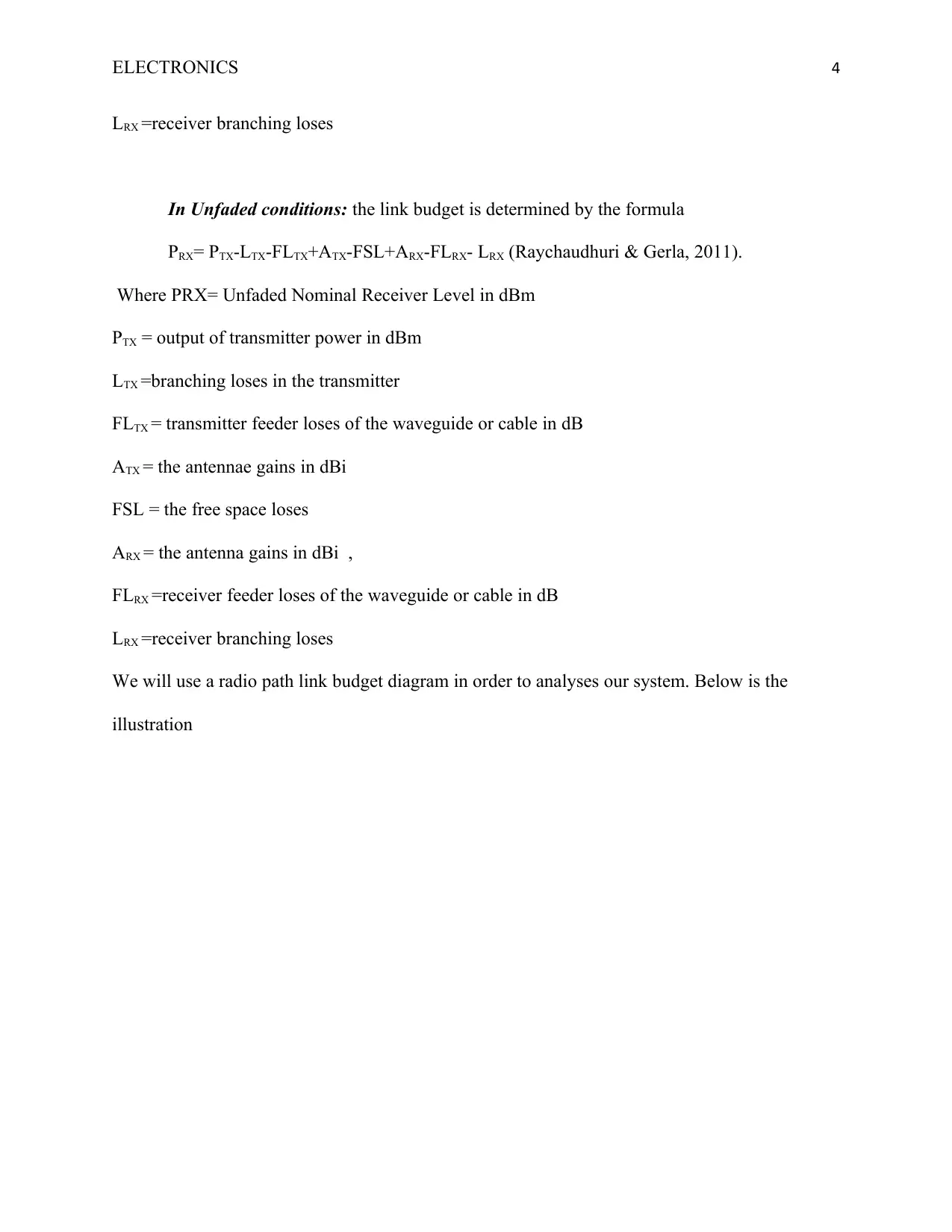
ELECTRONICS 4
LRX =receiver branching loses
In Unfaded conditions: the link budget is determined by the formula
PRX= PTX-LTX-FLTX+ATX-FSL+ARX-FLRX- LRX (Raychaudhuri & Gerla, 2011).
Where PRX= Unfaded Nominal Receiver Level in dBm
PTX = output of transmitter power in dBm
LTX =branching loses in the transmitter
FLTX = transmitter feeder loses of the waveguide or cable in dB
ATX = the antennae gains in dBi
FSL = the free space loses
ARX = the antenna gains in dBi ,
FLRX =receiver feeder loses of the waveguide or cable in dB
LRX =receiver branching loses
We will use a radio path link budget diagram in order to analyses our system. Below is the
illustration
LRX =receiver branching loses
In Unfaded conditions: the link budget is determined by the formula
PRX= PTX-LTX-FLTX+ATX-FSL+ARX-FLRX- LRX (Raychaudhuri & Gerla, 2011).
Where PRX= Unfaded Nominal Receiver Level in dBm
PTX = output of transmitter power in dBm
LTX =branching loses in the transmitter
FLTX = transmitter feeder loses of the waveguide or cable in dB
ATX = the antennae gains in dBi
FSL = the free space loses
ARX = the antenna gains in dBi ,
FLRX =receiver feeder loses of the waveguide or cable in dB
LRX =receiver branching loses
We will use a radio path link budget diagram in order to analyses our system. Below is the
illustration
Paraphrase This Document
Need a fresh take? Get an instant paraphrase of this document with our AI Paraphraser
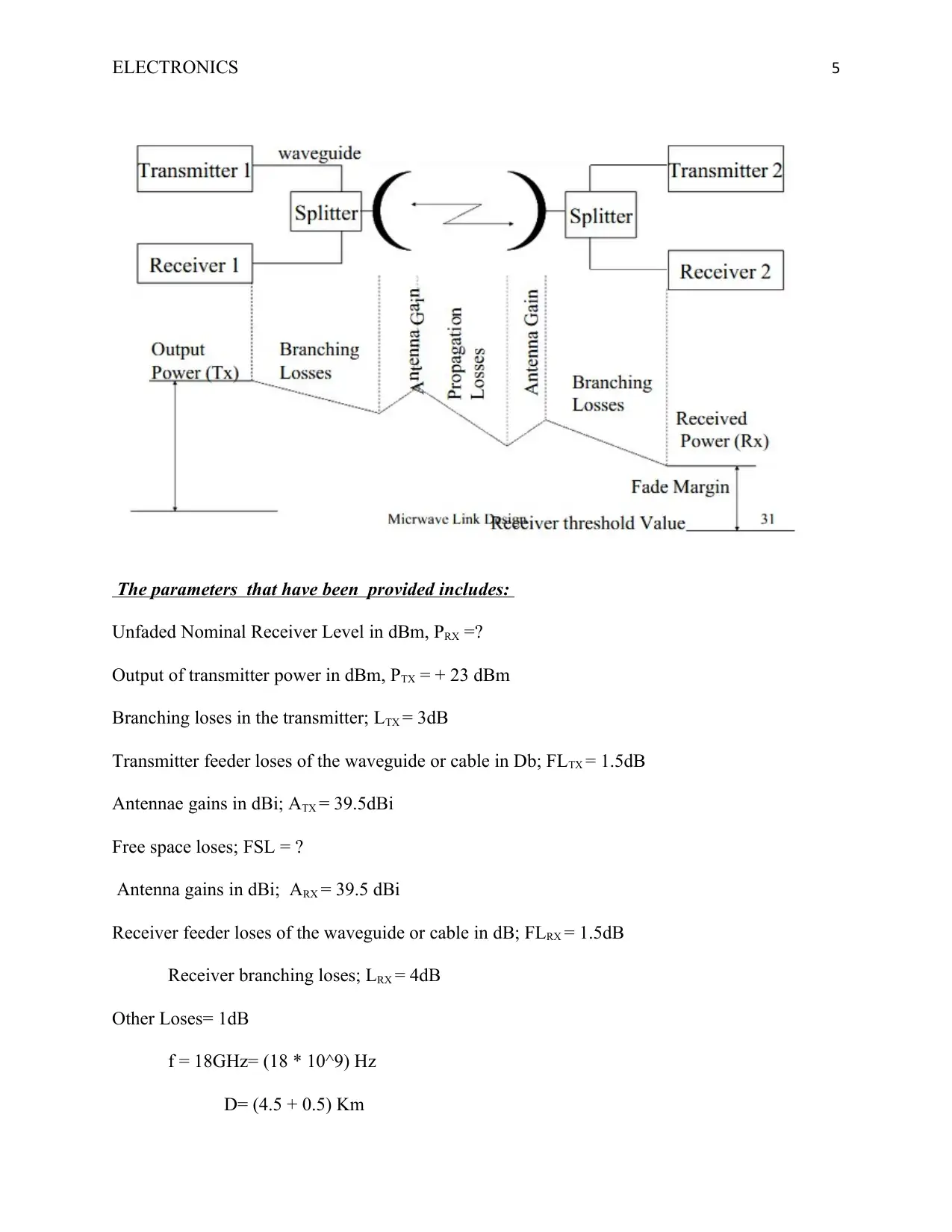
ELECTRONICS 5
The parameters that have been provided includes:
Unfaded Nominal Receiver Level in dBm, PRX =?
Output of transmitter power in dBm, PTX = + 23 dBm
Branching loses in the transmitter; LTX = 3dB
Transmitter feeder loses of the waveguide or cable in Db; FLTX = 1.5dB
Antennae gains in dBi; ATX = 39.5dBi
Free space loses; FSL = ?
Antenna gains in dBi; ARX = 39.5 dBi
Receiver feeder loses of the waveguide or cable in dB; FLRX = 1.5dB
Receiver branching loses; LRX = 4dB
Other Loses= 1dB
f = 18GHz= (18 * 10^9) Hz
D= (4.5 + 0.5) Km
The parameters that have been provided includes:
Unfaded Nominal Receiver Level in dBm, PRX =?
Output of transmitter power in dBm, PTX = + 23 dBm
Branching loses in the transmitter; LTX = 3dB
Transmitter feeder loses of the waveguide or cable in Db; FLTX = 1.5dB
Antennae gains in dBi; ATX = 39.5dBi
Free space loses; FSL = ?
Antenna gains in dBi; ARX = 39.5 dBi
Receiver feeder loses of the waveguide or cable in dB; FLRX = 1.5dB
Receiver branching loses; LRX = 4dB
Other Loses= 1dB
f = 18GHz= (18 * 10^9) Hz
D= (4.5 + 0.5) Km
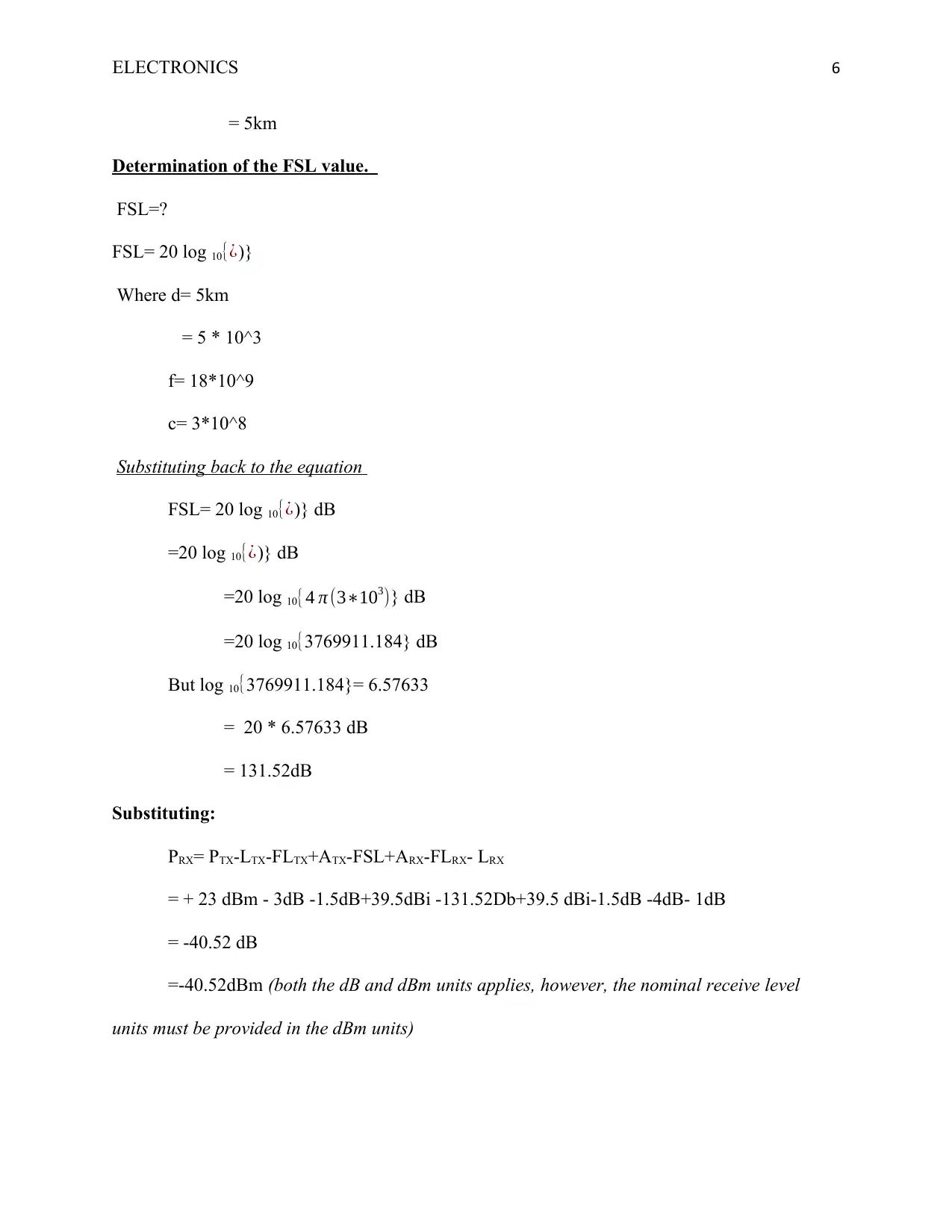
ELECTRONICS 6
= 5km
Determination of the FSL value.
FSL=?
FSL= 20 log 10{¿)}
Where d= 5km
= 5 * 10^3
f= 18*10^9
c= 3*10^8
Substituting back to the equation
FSL= 20 log 10{¿)} dB
=20 log 10{¿)} dB
=20 log 10{4 π (3∗103)} dB
=20 log 10{3769911.184} dB
But log 10{3769911.184}= 6.57633
= 20 * 6.57633 dB
= 131.52dB
Substituting:
PRX= PTX-LTX-FLTX+ATX-FSL+ARX-FLRX- LRX
= + 23 dBm - 3dB -1.5dB+39.5dBi -131.52Db+39.5 dBi-1.5dB -4dB- 1dB
= -40.52 dB
=-40.52dBm (both the dB and dBm units applies, however, the nominal receive level
units must be provided in the dBm units)
= 5km
Determination of the FSL value.
FSL=?
FSL= 20 log 10{¿)}
Where d= 5km
= 5 * 10^3
f= 18*10^9
c= 3*10^8
Substituting back to the equation
FSL= 20 log 10{¿)} dB
=20 log 10{¿)} dB
=20 log 10{4 π (3∗103)} dB
=20 log 10{3769911.184} dB
But log 10{3769911.184}= 6.57633
= 20 * 6.57633 dB
= 131.52dB
Substituting:
PRX= PTX-LTX-FLTX+ATX-FSL+ARX-FLRX- LRX
= + 23 dBm - 3dB -1.5dB+39.5dBi -131.52Db+39.5 dBi-1.5dB -4dB- 1dB
= -40.52 dB
=-40.52dBm (both the dB and dBm units applies, however, the nominal receive level
units must be provided in the dBm units)
⊘ This is a preview!⊘
Do you want full access?
Subscribe today to unlock all pages.

Trusted by 1+ million students worldwide
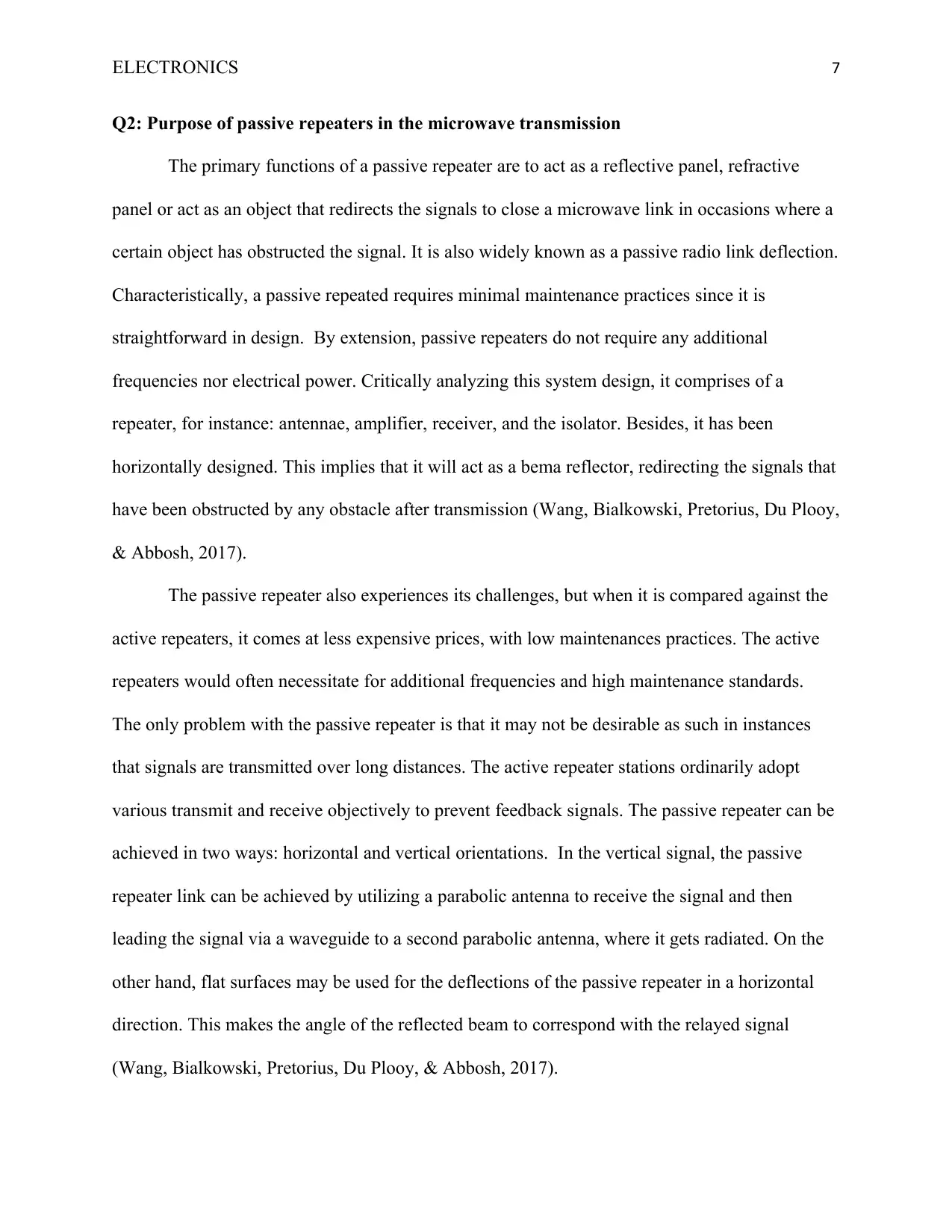
ELECTRONICS 7
Q2: Purpose of passive repeaters in the microwave transmission
The primary functions of a passive repeater are to act as a reflective panel, refractive
panel or act as an object that redirects the signals to close a microwave link in occasions where a
certain object has obstructed the signal. It is also widely known as a passive radio link deflection.
Characteristically, a passive repeated requires minimal maintenance practices since it is
straightforward in design. By extension, passive repeaters do not require any additional
frequencies nor electrical power. Critically analyzing this system design, it comprises of a
repeater, for instance: antennae, amplifier, receiver, and the isolator. Besides, it has been
horizontally designed. This implies that it will act as a bema reflector, redirecting the signals that
have been obstructed by any obstacle after transmission (Wang, Bialkowski, Pretorius, Du Plooy,
& Abbosh, 2017).
The passive repeater also experiences its challenges, but when it is compared against the
active repeaters, it comes at less expensive prices, with low maintenances practices. The active
repeaters would often necessitate for additional frequencies and high maintenance standards.
The only problem with the passive repeater is that it may not be desirable as such in instances
that signals are transmitted over long distances. The active repeater stations ordinarily adopt
various transmit and receive objectively to prevent feedback signals. The passive repeater can be
achieved in two ways: horizontal and vertical orientations. In the vertical signal, the passive
repeater link can be achieved by utilizing a parabolic antenna to receive the signal and then
leading the signal via a waveguide to a second parabolic antenna, where it gets radiated. On the
other hand, flat surfaces may be used for the deflections of the passive repeater in a horizontal
direction. This makes the angle of the reflected beam to correspond with the relayed signal
(Wang, Bialkowski, Pretorius, Du Plooy, & Abbosh, 2017).
Q2: Purpose of passive repeaters in the microwave transmission
The primary functions of a passive repeater are to act as a reflective panel, refractive
panel or act as an object that redirects the signals to close a microwave link in occasions where a
certain object has obstructed the signal. It is also widely known as a passive radio link deflection.
Characteristically, a passive repeated requires minimal maintenance practices since it is
straightforward in design. By extension, passive repeaters do not require any additional
frequencies nor electrical power. Critically analyzing this system design, it comprises of a
repeater, for instance: antennae, amplifier, receiver, and the isolator. Besides, it has been
horizontally designed. This implies that it will act as a bema reflector, redirecting the signals that
have been obstructed by any obstacle after transmission (Wang, Bialkowski, Pretorius, Du Plooy,
& Abbosh, 2017).
The passive repeater also experiences its challenges, but when it is compared against the
active repeaters, it comes at less expensive prices, with low maintenances practices. The active
repeaters would often necessitate for additional frequencies and high maintenance standards.
The only problem with the passive repeater is that it may not be desirable as such in instances
that signals are transmitted over long distances. The active repeater stations ordinarily adopt
various transmit and receive objectively to prevent feedback signals. The passive repeater can be
achieved in two ways: horizontal and vertical orientations. In the vertical signal, the passive
repeater link can be achieved by utilizing a parabolic antenna to receive the signal and then
leading the signal via a waveguide to a second parabolic antenna, where it gets radiated. On the
other hand, flat surfaces may be used for the deflections of the passive repeater in a horizontal
direction. This makes the angle of the reflected beam to correspond with the relayed signal
(Wang, Bialkowski, Pretorius, Du Plooy, & Abbosh, 2017).
Paraphrase This Document
Need a fresh take? Get an instant paraphrase of this document with our AI Paraphraser
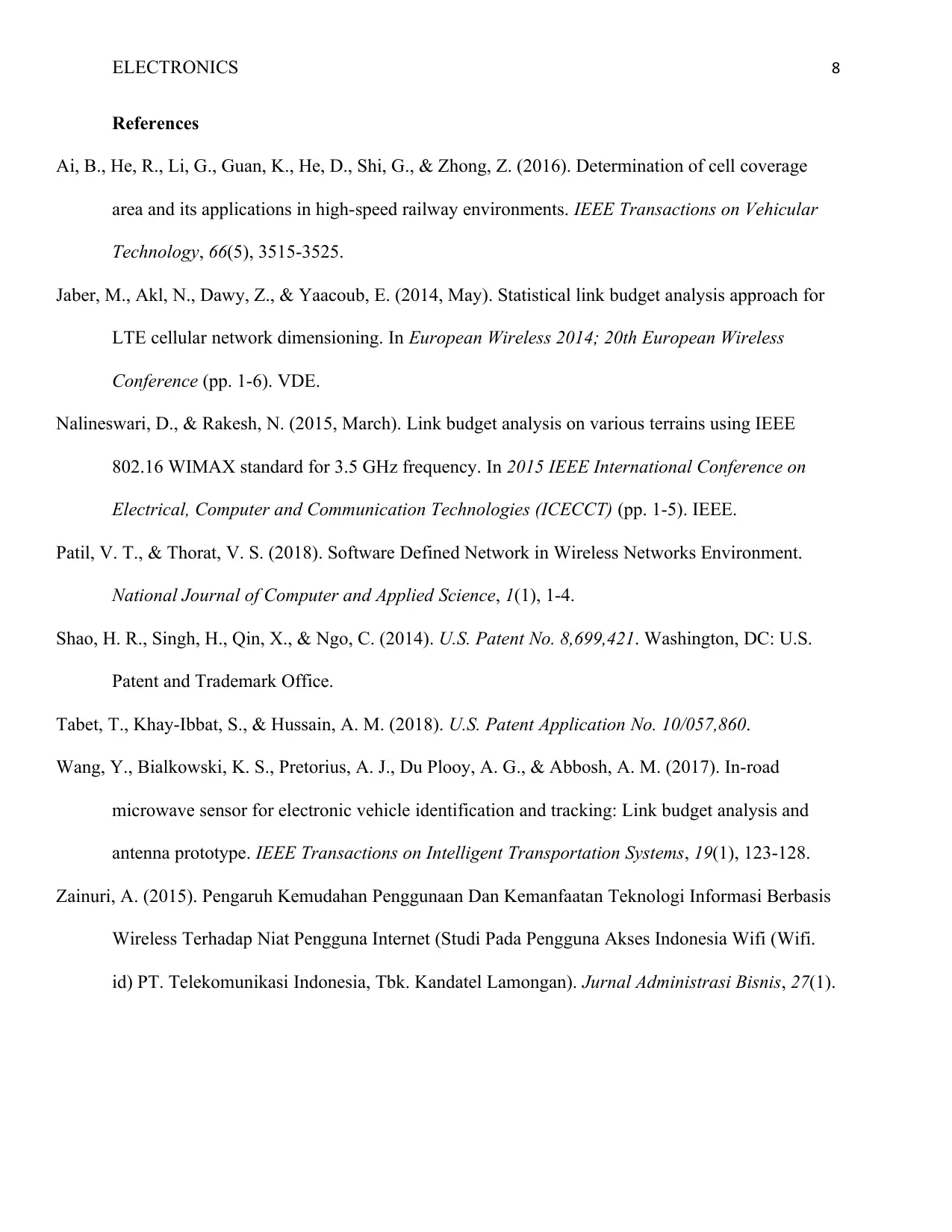
ELECTRONICS 8
References
Ai, B., He, R., Li, G., Guan, K., He, D., Shi, G., & Zhong, Z. (2016). Determination of cell coverage
area and its applications in high-speed railway environments. IEEE Transactions on Vehicular
Technology, 66(5), 3515-3525.
Jaber, M., Akl, N., Dawy, Z., & Yaacoub, E. (2014, May). Statistical link budget analysis approach for
LTE cellular network dimensioning. In European Wireless 2014; 20th European Wireless
Conference (pp. 1-6). VDE.
Nalineswari, D., & Rakesh, N. (2015, March). Link budget analysis on various terrains using IEEE
802.16 WIMAX standard for 3.5 GHz frequency. In 2015 IEEE International Conference on
Electrical, Computer and Communication Technologies (ICECCT) (pp. 1-5). IEEE.
Patil, V. T., & Thorat, V. S. (2018). Software Defined Network in Wireless Networks Environment.
National Journal of Computer and Applied Science, 1(1), 1-4.
Shao, H. R., Singh, H., Qin, X., & Ngo, C. (2014). U.S. Patent No. 8,699,421. Washington, DC: U.S.
Patent and Trademark Office.
Tabet, T., Khay-Ibbat, S., & Hussain, A. M. (2018). U.S. Patent Application No. 10/057,860.
Wang, Y., Bialkowski, K. S., Pretorius, A. J., Du Plooy, A. G., & Abbosh, A. M. (2017). In-road
microwave sensor for electronic vehicle identification and tracking: Link budget analysis and
antenna prototype. IEEE Transactions on Intelligent Transportation Systems, 19(1), 123-128.
Zainuri, A. (2015). Pengaruh Kemudahan Penggunaan Dan Kemanfaatan Teknologi Informasi Berbasis
Wireless Terhadap Niat Pengguna Internet (Studi Pada Pengguna Akses Indonesia Wifi (Wifi.
id) PT. Telekomunikasi Indonesia, Tbk. Kandatel Lamongan). Jurnal Administrasi Bisnis, 27(1).
References
Ai, B., He, R., Li, G., Guan, K., He, D., Shi, G., & Zhong, Z. (2016). Determination of cell coverage
area and its applications in high-speed railway environments. IEEE Transactions on Vehicular
Technology, 66(5), 3515-3525.
Jaber, M., Akl, N., Dawy, Z., & Yaacoub, E. (2014, May). Statistical link budget analysis approach for
LTE cellular network dimensioning. In European Wireless 2014; 20th European Wireless
Conference (pp. 1-6). VDE.
Nalineswari, D., & Rakesh, N. (2015, March). Link budget analysis on various terrains using IEEE
802.16 WIMAX standard for 3.5 GHz frequency. In 2015 IEEE International Conference on
Electrical, Computer and Communication Technologies (ICECCT) (pp. 1-5). IEEE.
Patil, V. T., & Thorat, V. S. (2018). Software Defined Network in Wireless Networks Environment.
National Journal of Computer and Applied Science, 1(1), 1-4.
Shao, H. R., Singh, H., Qin, X., & Ngo, C. (2014). U.S. Patent No. 8,699,421. Washington, DC: U.S.
Patent and Trademark Office.
Tabet, T., Khay-Ibbat, S., & Hussain, A. M. (2018). U.S. Patent Application No. 10/057,860.
Wang, Y., Bialkowski, K. S., Pretorius, A. J., Du Plooy, A. G., & Abbosh, A. M. (2017). In-road
microwave sensor for electronic vehicle identification and tracking: Link budget analysis and
antenna prototype. IEEE Transactions on Intelligent Transportation Systems, 19(1), 123-128.
Zainuri, A. (2015). Pengaruh Kemudahan Penggunaan Dan Kemanfaatan Teknologi Informasi Berbasis
Wireless Terhadap Niat Pengguna Internet (Studi Pada Pengguna Akses Indonesia Wifi (Wifi.
id) PT. Telekomunikasi Indonesia, Tbk. Kandatel Lamongan). Jurnal Administrasi Bisnis, 27(1).

ELECTRONICS 9
⊘ This is a preview!⊘
Do you want full access?
Subscribe today to unlock all pages.

Trusted by 1+ million students worldwide
1 out of 9
Related Documents
Your All-in-One AI-Powered Toolkit for Academic Success.
+13062052269
info@desklib.com
Available 24*7 on WhatsApp / Email
![[object Object]](/_next/static/media/star-bottom.7253800d.svg)
Unlock your academic potential
© 2024 | Zucol Services PVT LTD | All rights reserved.




